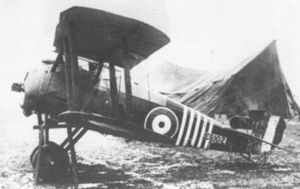Sopwith Snipe
| 7F.1 Snipe | |
|---|---|
 |
|
| William George Barker's Snipe | |
| Role | Fighter |
| Manufacturer | Sopwith Aviation Company |
| Designer | Herbert Smith |
| First flight | October 1917 |
| Introduction | 1918 |
| Primary users |
Royal Air Force Australian Flying Corps Canadian Air Force |
| Number built | 497 |
| Variants |
Sopwith Salamander Sopwith Dragon |
The Sopwith 7F.1 Snipe was a British single-seat biplane fighter of the Royal Air Force (RAF). It was designed and built by the Sopwith Aviation Company during the First World War, and came into squadron service a few weeks before the end of the conflict, in late 1918.
The Snipe was not a fast aircraft by the standards of its time, but its excellent climb and manoeuvrability made it a good match for contemporary German fighters.
It was selected as the standard postwar single-seat RAF fighter and the last examples were not retired until 1926.
In April 1917, Herbert Smith, the chief designer of the Sopwith Company, began to design a fighter intended to be the replacement for Sopwith's most famous aeroplane, the successful Sopwith Camel. The resultant design, called Snipe by Sopwith, was in its initial form a single-bay biplane, slightly smaller than the Camel, and intended to be powered by similar engines. The pilot sat higher than in the Camel while the centre-section of the upper wing was uncovered, giving a better view from the cockpit. Armament was to be two Vickers machine guns. In the absence of an official order, Sopwith began construction of two prototypes as a private venture in September 1917. This took advantage of a licence that had been granted to allow construction of four Sopwith Rhino bomber prototypes, only two of which were built. The first prototype Snipe, powered by a Bentley AR.1 rotary engine was completed in October 1917. The second prototype was completed with the new, more powerful Bentley BR.2, engine, which gave 230 horsepower (170 kW) in November 1917. This promised better performance, and prompted an official contract for six prototypes to be placed, including the two aircraft built as private ventures.
The third prototype to fly, serial number B9965, had modified wings, with a wider centre-section and a smaller cutout for the pilot, while the fuselage had a fully circular section, rather than the slab-sided one of the first two aircraft, and the tail was smaller. It was officially tested in December 1917, reaching a speed of 119 mph (192 km/h), and was then rebuilt with longer-span (30 ft (9.14 m)) two-bay wings (compared with the 25 ft 9 in (7.85 m) single bay wings). This allowed the Snipe to compete for Air Board Specification A.1(a) for a high-altitude single-seat fighter. This specification required a speed of at least 135 mph (225 km/h) at 15,000 ft (4,573 m) and a ceiling of at least 25,000 ft (7,620 m) while carrying an armament of two fixed and one swivelling machine gun. An oxygen supply and heated clothing were to be provided for the pilot to aid operation at high altitude.
...
Wikipedia
